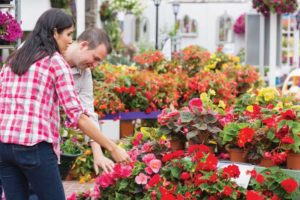How You Can Use Lifestyle Marketing to Sell Plants
 Our industry is beginning to understand that we won’t be able to create interest in our products, unless we go out and talk to people. Too often, our attempts at communication with consumers turn into clumsy sermons on the benefits of unpleasant garden chores. It does not have to be this way.
Our industry is beginning to understand that we won’t be able to create interest in our products, unless we go out and talk to people. Too often, our attempts at communication with consumers turn into clumsy sermons on the benefits of unpleasant garden chores. It does not have to be this way.
In a nondescript strip mall in southern Ontario, we can find a model for a refreshingly innovative way of marketing floral products. James Sawatsky’s Stems Etc. florist store is not just a place where people go when they need to buy flowers. This is a place where you might like to socialize after work. Usually, you’ll find some like-minded people there, but even when you’re alone, you are invited to linger and chat in this unique ambiance, surrounded by a trove of exquisite, albeit pricey, little gems from superb dark chocolate truffles to Artisan perfumes.
How to Turn Floral Products Into Luxury Items
None of the products at Stems Etc. are marketed to your face. Prices are discreetly advertised. The quality and uniqueness of these products is excellent. The unobtrusive manner in which the merchandise is integrated into the display relaxes the customer, induces spontaneity, and incites them to treat themselves with something special.
While some of the sales go to ultra-premium food items, many visitors find themselves leaving with flowers or potted plants, even though the typical clientele does not belong to the green-thumb gardener segment. Sawatsky has found a way to position his floral product in the category of a desirable luxurious treat. This is lifestyle marketing at its best.
Sawatsky is taking a promising stab at repositioning floral product within the realm of refined style. He lifts Napa wine and California extra virgin olive oils from insipid blandness onto the radar of ultra-premium shoppers in a similar manner.
Smaller Retailers Need Premium Floral Products for Reasonable Costs
Sawatsky told me he would like to offer more floral products. He believes that he has the potential to sell more flowers — a lot more flowers — as long as he can offer more exclusive choice, better quality, and longer shelf-life than competing supermarket outlets. He has the potential to sell high-value cut flowers and potted plants that come with a perception of exclusivity. His problem is that he cannot find them.
Wholesale distributors do not focus on small, diversified stores. They create bulk sales by chain store merchandising and independent stores are tagged onto these volumes as an afterthought. Sawatsky told me that his wholesale price is often higher than the retail price advertised for identical product in the chain-store competition, and it still does not give him the differentiation that he needs. For our own industry, this is not a good place to be if we want to expand retail sales of floral product to this new lifestyle clientele.
Sawatsky says he sees opportunity for local growers in producing small batches of a broad variety of high-quality cuts. His store would be able to afford the necessary higher producer price tag, as long as he does not have to compete with the typical volume dumps at chain stores. But there’s the catch: Greenhouse producers are not keen on supplying him directly with fresher product, even if they can achieve better prices than on the wholesale market. We have no effective value chain for high quality, high value floral product. Growers are reluctant to experiment with production of upscale floral merchandise whenever it falls outside of the scope of what lends itself to the needs of large wholesalers.
Moving From a Production-Ease Mindset to a Consumer Focused One
Are growers merely afraid to compete with their own bread-and-butter production that feeds the discount outlets? If we cannot supply products that fall outside of our current box, how can we expect to attract consumers that have lost interest in our box-sized discount merchandise? Should we be trying to educate consumers into loving what we like to produce, or should we allow consumers to educate us into producing what they love?
I believe that Robert Parker got it right when he took on winemakers all over the world and told them they had to let go of cherished traditions and listen to consumer taste if they wanted to sell more juice. I could see many of the old-fashioned, high-end floral products find revival in a retail model driven by consumers seeking nothing but hedonistic pleasure from premium quality. Maybe we should ask Robert Parker for advice.










